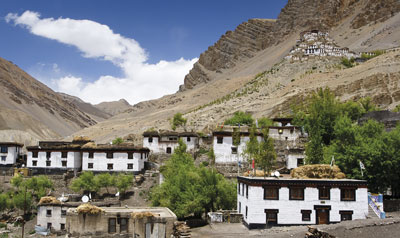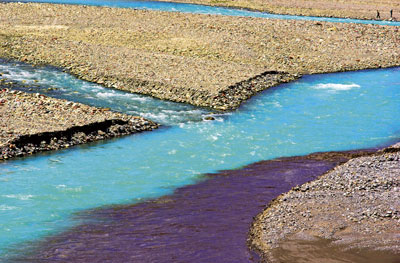 |
THE SPITI VALLEY: THE LAND IN THE MIDDLELow, whitewashed houses press tightly against one another. A swarthy, dark-haired woman in a brightly-coloured shalwar-kameez and woollen shawl pours green tea into drinking bowls. The gilded roof of a Buddhist temple glistens in the sun. I glance even higher, where white pinnacles touch the clouds. I am breathing heavily, but it is hardly because of the height; rather,
I am gasping at the sight of all this unreal, cosmic and limitless splendour.
We are in the Spiti Valley, a patch of Tibet in India's north.
Hidden in the Snows
Modern Tibet consists of several detached parts. In
the middle, there is China's autonomous region of
Tibet, home to Lhasa, the "city of the gods", where
weary pilgrims traditionally make their way to the
sacred Mount Kailash. A mere century ago, foreigners
were refused access to Tibet, so these lands were
reached only by the most tenacious travellers, such as
Gombojab Tsybikov, who had to disguise as a Buryat
lama and walk with a caravan for months. To visit
Lhasa today, one has to apply for a permit, which is
easily obtained with a package tour.

But historic Tibet is twice as big as the Tibetan autonomous
region. Its other territories are divided
administratively into the Chinese provinces of
Gansu, Xinhai, Sichuan and Yunnan, in addition to
"Minor Tibet", comprising the north Indian regions
of Ladakh, Zanskar and Spiti. Small, cold and sparsely
populated, Spiti is hidden in the Himalayan snows, on
the border of the Tibetan plateau and the Indian state
of Himachal Pradesh. The word "Spiti" can be translated
as "the land in the middle".
The Dark Past of Buddhist
Kingdoms
For a long stretch of time, Tibet was split
into kingdoms that, at times, coexisted
peacefully and, at other times, fought
one another. From the 7th to 9th centuries,
central Tibet was ruled by the powerful
Yarlung Dynasty. King Songtsan
Gampo introduced Buddhism to Tibet.
In the mid-9th century, the dynasty collapsed.
An ambitious descendant of the
fallen kings, a certain Nyima Gon, later
conquered the western margins of Tibet
and united them, including Spiti, into one
realm. 
Following the rule of Nyima Gon, the
vast territorial possessions were divided
among his three sons. The elder brother
inherited the powerful kingdom of
Ladakh, while the deserted and poor Spiti
was given to the younger one. Later, the
rulers of Ladakh would occasionally send the army to the vassal valley as an assertion of their
power. However, Spiti's inhabitants were not to be
caught off-guard: sentinels were watchful on the high
mountain ridges and precipices and would light signal
bonfires at the sight of the enemy. When in danger,
everyone assembled in the fortresses specifically
erected on steep cliffs, which were extremely difficult
to access. Even monasteries and residences in Spiti
were built as defence structures – with thick walls,
tiny porthole windows and heavy wooden doors with
massive locking bars.
In the 17th century, Spiti was left alone by the Ladakh
rulers who were faced with a threat in the form of
the Moguls. In the 19th century, Spiti came under the
control of the Sikhs, whose ambitions plans were to
conquer central Tibet. After the Anglo-Sikh wars in
the mid-19th century, the region came under the control
of the British East India Company. In 1947, India
obtained its long-awaited independence, and Spiti
became part of the state of Punjab. In 1966, the Spiti
Valley was annexed to the state of Himachal Pradesh,
in whose most remote corner it lies today.
Never Losing Heart
To anyone who grew up in a warm climate, Spiti hardly
looks hospitable. There are very few sites located
lower than 3,000 metres, while villages and nomad
camps can be found as high as 4,000 metres above sea
level. Impressive, all covered in deep crevices, glaciers
flow to the foot of the snow-capped mountains. Birds
of prey build their nests on the dead mountains. It's
very dry here and there is no forest whatsoever. Local
people tend to their few plants as others care for their
in-house conservatories. The wind is frequent here,
dry and prickly.
The harsh climate is compensated by the splendour
of the landscape. Against the backdrop of chocolatetruffle
and snowy-streaky mountains crouch tiny, neat
villages. Down below flow baby-blue bands of a river
meandering through the small squares of fields. Here
and there are massive, grotesque formations of sand,
clay and stones; these are ancient deposits of the former
riverbed, ground by the wind and rain to the perfection
of jewellery.
When you come to Spiti for the first time, you can't
help but think that someone must have invented a
time machine. This region seems not to have changed
since mediaeval times. Houses are still built from
unburnt clay bricks. Like centuries before, nomads
drive their herds of yaks to alpine pastures. In ancient
Buddhist temples, the same services are held where
young monks learn mantras under the supervision
of knowledgeable mentors. Spiti had been long isolated;
up to the 1960s when a strategic road between
India and China was built, one could reach the valley
only via highland passes that were accessible several
months a year. 
The menu of the local people is very humble: barley,
wheat, rice, milk, butter, yoghurt and meat, while
vegetables and fruits are lacking. Several times a day,
women brew green tea in their sooty teapots, adding
in some yak butter. This beverage that looks more
like a soup helps fight the cold and dry conditions of
the highland. If you first put some barley flour and
dried yak cheese in a drinking bowl, then pour in
the buttery, salted tea and stir it, invariably with your
fingers as locals do, you will end up with tsampa –
the Tibetan's staple food. Guests are welcomed with
chang – barley beer that is said to help you keep warm.
"Once a yeti came to our village and drank several litres
of our chang", an acquaintance from Spiti prone
to believing in myths and legends proudly tells me.
Rare tourists come here over the summer, yet
they wrap themselves in rugs and woollen shawls.
Blackouts happen and could last from two to three
days. Europeans deprived of the opportunity to charge
their photo cameras and cell phones are indignant
over the lack of electricity, while local Spiti dwellers
only shake their heads and keep on smiling, like
all Tibetans do. Obviously, nothing can upset their
routine.
Away from the Changes of Time
Since the arrival of Buddhism in the 9th and 10th centuries,
the people of Spiti have whispered mantras daily
while counting the 108 beads that must correspond
to the number of syllables pronounced. While resting,
they turn praying drums, inside of which are tattered
scrolls with sacred scriptures. Each home has an altar
adorned with a picture of the Dalai Lama surrounded
by colourful buddhas and multi-armed bodhisattvas,
richly decorated and seated on lotus flowers.
Every morning, deities are offered seven small
cups filled with water. On the roofs of houses, stupas
and temples fly red, yellow, white, green and blue
banners. It is believed that the strong Tibetan wind
will read the prayers printed on them with the help
of wooden printing blocks, and will spread them
around the world. There is hardly a family that does
not have at least one member who is a monk or who
lives in a monastery mastering Buddhist teachings.
But some changes did reach Spiti. During service
breaks, monks make calls from their cell phones, the
roofs of houses flaunt solar panels and satellite dishes,
kids munch away on crispy chips and chocolate
biscuits and the former Silk Road path is ridden by
Indian jalopies. But as long as serious international
organisations take care of the decrepit ancient monasteries,
the people of the Spiti Valley, emitting serenity,
will ritually walk around their gompas for the
millionth time. It looks like Tibetan piety, like the
endless blue skies and the eternal reddish-brown
mountains, is immune to the changes of time.
Text by Antonina Zakharova
Photos by Antonina Zakharova
and Pavel Borisov
|
|
 +65 6696 7068
+65 6696 7068
 info@meridian103.com
info@meridian103.com
 PDA
PDA
 +65 6696 7068
+65 6696 7068
 info@meridian103.com
info@meridian103.com
 PDA
PDA
